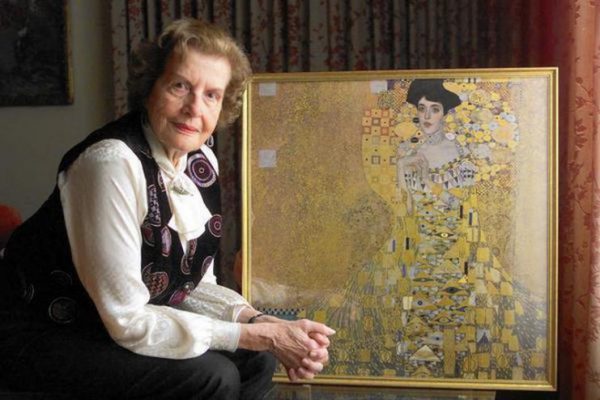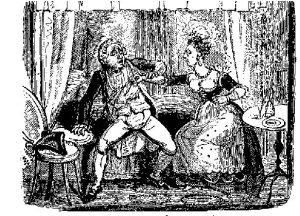Maria Altmann was alone in her home in Los Angeles, California, sitting there and thinking. She was thinking about all the heartache she had gone through in the span of her life so far, and thinking about those brutal years that she had had to live through in Vienna. She was thinking about her family and all of the possessions that had been taken from her by the Nazi’s, that she knew she was to never going see again, and especially she was thinking about the beautiful portrait of her aunt, Adele Bloch-Bauer, that embodied her aunt in a way that her memory never could. Not wanting to just think about all this, she decided to take action, and in 1998 she called Randol Schoenberg to begin the process of getting back the Portrait of Adele Bloch-Bauer I.
Maria Altmann and her husband fled Vienna in 1938, leaving her parents behind to go to the U.S. She had decided to start over and make a life of her own. Her husband and she were victims of an escalating antisemitism in the now German-held Austria, which was why they fled to America. They had subsequently lived well for fifty-six years until her husband had passed away due to a stroke and then a fall in 1994, leaving her solitary and to her thoughts, which kept on going back to the family that she had to leave behind in Vienna.1 Feeling alone and sad, she began to think back to the harsh years that she had lived in Vienna with her family, and she began to feel a need to reconnect somehow with that family that was no longer around. When she got a call in February of 1998 from an old friend in Vienna, informing her about an article that had appeared in the newspaper about the Bloch-Bauer Klimt collection, and it made her mad, because the Austrians had taken everything away from her.2 A few weeks had passed, she had done a lot of contemplating about the new information that she had learned, but her thoughts remained on the paintings, and on her dear aunt Adele Bloch-Bauer, and she started to think about the one particular painting of her.

There had been a total of six paintings that were looted from her uncle’s house by the Nazis in the 1930s, and Maria had decided that she wanted them all back, especially the Portrait of Adele Bloch-Bauer I.3 The Portrait of Adele Bloch-Bauer I was painted in 1907 by Gustav Klimt and had originally belonged to the Bloch-Bauer’s before it was looted by the Nazi’s, and then taken into the Austrian government’s possession. When she contacted Randol in September of 1998, he was unsure about taking on the case. He had a lot of Austrian roots that ran deep, but he felt as though he had no real connection to this at all. After talking with Maria about the subject for a while, he decided to do a little bit of research, which led him to the Restitution Law, which then led him to agree to take up the case, and so he brought it up to his boss. His boss agreed and thought that this would be a compelling case, but that he wasn’t quite sure that it was worth the firm’s time and referred to it as a long-shot case. But Randol was now determined, and if he had to, he would pursue the Altmann case on his own, which started the odd pairing of Randol and Maria versus Austria.4
In 1999, the suit was filed against the Republic of Austria in an Austrian court. This was the beginning of her efforts to get the paintings back, but she then dismissed the case because she didn’t have enough funds to pay the attorney fees. So, in being unable to bring suit in Austria, she then decided to try her luck and refile her suit in the U.S. District Court for the Central District of California. Her claim was that the confiscation of property was in violation of international law, which was better known as the Foreign Sovereign Immunities Act (FSIA), and brought that against not only Austria but the Austrian Gallery as well. Mr. Shoenberg and Ms. Altmann took a huge risk in submitting their case to binding arbitration in Austria.5 Once their case had been submitted and approved, they kept on thinking about what their next step would be and how to go about it, due to the fact that this was a very delicate case that they needed to treat with care. As they continued to think of their next steps, Mr. Shoenberg began to communicate by email with an investigative reporter from Austria named Hubertus Cerzin. As the emails progressed, Mr. Shoenberg learned that Mr. Cerzin was on the same side as him and Ms. Altmann, and also grew as impatient as them due to the fact that he was seriously ill. They talked about requesting the wording of Adele’s will, but that it had to be done in such a way that it would not seem as if they were demanding it. As their correspondence continued, he informed Randol on December 19, 1998, that he had asked Frodl to fax him Adele’s last will, but that he did not want to, due to the fact that Frodl believed that if he did, the will would be sent around the world.6 With the continuous back and forth of them trying to get Adele’s will, and Frodl and people like him saying that they couldn’t give it to them, Hubertus got fed up with it all. So he reached out to moles that he had in the Vienna archives, because they needed the will; it was the key to the whole case. After more time, and waiting on Hubertus’s part for his mole to get his hands on the will, he finally sent word back to Mr. Shoenberg in January 1999. Fax had begun to scroll into Mr. Shoenberg’s office, and it was Adele’s will.7

While Shoenberg and Hubertus were dealing with getting Adele’s will, Maria Altmann had been going through a separate series of events as well as the same ones that Shoenberg had been going through. This was all a lot more personal for her. It was her history and she was trying to right it. She had to go to Austria, after not having being there since 1938. It was hard for her, seeing how some things from her childhood had changed, but others remained. In March of 1999, her spirits began to soar, and her resolve was growing stronger, due to the fact that she had been invited to speak at a restitution conference. She was a woman on a mission, and she was determined in setting out to settle a score with history.8 She had taken a taxi, and along the way, she asked the driver to stop at Karl-Lueger-Platz, as well as the front door of the place she once called home, Strubenbastei, and at both places, she was filled with nostalgia as well as sadness, because it wasn’t exactly how she remembered it. It had changed as time had passed, and although she recognized the places, they weren’t the same. While still standing on the path in front of her old home, and being filled with all of these emotions, she realized that the Austrians had stolen her family’s life, and in return had not offered any contribution. She then went on to hail a cab to take her to the Belvedere, where she went on to seek out the gorgeous painting of her aunt. As she stared at it, she was filled with many memories that she had with her aunt, and felt at peace as she continued to stare. As a few minutes passed, she asked someone to take a picture of her in front of the painting, and as the flash went off, a guard came over to tell them that pictures were prohibited, which angered Maria because that painting was of her aunt and belonged to her family.9
As events continued to progress, they began to escalate quicker, starting with the Austrian panel recommending against the return of the Klimt paintings in June, saying that only sixteen of the Klimt drawings of Adele and pieces of Ferdinand’s porcelain should be returned. Although this decision was not unanimous due to one of the panelists protesting against the decision, it still infuriated Maria and Mr. Shoenberg. Maria wrote that the Belvedere “is not the legal owner of these paintings,” and that they were “keenly aware of the Gold Portrait’s importance as a national treasure. Once the Beirat decides to recognize our legal right to the paintings, we would then be in a position to work out a way with you that leaves the portrait in Vienna.” Even though Maria was very reasonable with what she was asking, she never received a response to her letter. This infuriated Shoenberg even further, as he went on to exclaim that “the world now knows that the Klimt paintings are Nazi-looted art. No amount of whitewashing, or legalistic argumentation can erase that fact.” He even went as far as trashing a fragile china shop that was in Vienna.10
As the months passed and then turned into years, Altmann and Shoenberg continued their dance with the Austrian court. They became more stressed, due not only to the case but to personal issues as well. Shoenberg had a young daughter, Dora, and a son on the way, which had him stressed, as well as having Crohn’s disease, which made him hard to insure. So in April of 2000, he ended up quitting his job.11 Maria, on the other hand, began to wonder whether she would ever be able to see the end of this long and tiring case that she had begun.

Even though Maria was losing hope in her search for justice, and was becoming tired of all the continuous arguing back and forth with the U.S. District Court for Central District of California, she argued that her case was valid due to the fact that the “Austrian Gallery’s present day publishing and advertising activities of the Klimt paintings in the United States satisfied the commercial activity condition.” And even though she made a very valid point with that argument, Austria continued arguing that they were immune from the jurisdiction of the U.S. federal and stated courts under the FSIA, because the allegations had occurred before the FSIA was enacted. The FSIA is a United States law that establishes the limitations on a foreign sovereign nation (or its political subdivisions, agencies, or instrumentalities) on whether it can be sued in United States courts, at the federal or state levels. After waiting for a response from the U.S. Supreme Court, and losing hope that it would go her way, in 2004 the vote was held. By a six to three vote, it had been ruled that the FSIA did, in fact, apply to pre-1952 conduct, and so she had the right to pursue her claim.12 This was decided because, “As a result, the Court changed the face of the FSIA and reversed years of precedent to the contrary. The Court in Altmann decided that the Austrian government could not expect immunity in light of its complicity in and perpetuation of the expropriation of the Klimt paintings.”13
As the case continued to progress, the Austrian government continued to throw curveballs at the case whenever they could, but that did not deter Maria nor Shoenberg from the goal they had set. The case had been gaining a lot more attention than anyone had anticipated, which was making Austria grow concerned. And with it being decided that Maria and other heirs would be receiving a $21.8 billion award from a Swiss restitution fund in April of 2005, it made it clear that the tides were turning, and quickly. The Austrians even went as far as giving Maria the offer to submit the case to binding arbitration with a panel of Austrian legal experts, which Mr. Shoenberg thought they should take, if she would want the case to be decided in her lifetime. Maria had called him crazy, but after talking it through with him, she had agreed.14

Once Shoenberg had made his points for the return of the paintings, and the Austrian lawyers made their points against it. Three arbitrators gathered to make the final decision on January 15, 2006. The room became tenser, as the final decision was about to be made, and Maria couldn’t help but feel nervous, because the ruling would determine whether she had wasted all of these years of her life, or not. As the three arbitrators had called everyone back in to say the final hearing, the Austrians were sure that they had won, while Maria was deflated in her seat being sure that she had lost. But with a turn of events, Mr. Shoenberg had won the case!15 Maria was overjoyed in learning that she had not, in fact, wasted years of her life. She was then later on asked about the future of the paintings; she replied that they belonged on public display because she wouldn’t want a private buyer to get them, due to the fact that they are meaningful to her and that she wanted to share them with everyone else.16
Once the paintings were back in her possession, she decided to then sell the Portrait of Adele Bloch-Bauer I on behalf of her family to the Neue Galerie in New York City, and since then it has been on display there.17 The perseverance that she had shown throughout the whole ordeal helped to inspire many other people, including countries as well, to get back what was rightfully theirs, no matter how long it took.
- Anne-Marie O’Conner, The Lady in Gold: The Extraordinary Tale of Gustav Klimt’s Masterpiece, Portrait of Adele Bloch-Bauer (New York: Knopf, 2012), 225. ↵
- Anne-Marie O’Conner, The Lady in Gold: The Extraordinary Tale of Gustav Klimt’s Masterpiece, Portrait of Adele Bloch-Bauer (New York: Knopf, 2012), 226. ↵
- Sue Choi, “The Legal Landscape of the International Art Market After Republic of Austria v. Altmann,” Northwestern Journal of International Law & Business 26, no. 1 (Fall 2005): 171. ↵
- Anne-Marie O’Conner, The Lady in Gold: The Extraordinary Tale of Gustav Klimt’s Masterpiece, Portrait of Adele Bloch-Bauer (New York: Knopf, 2012), 228. ↵
- William Grimes, “Maria V. Altmann Pursuer of Family Klimts, Dies at 94.” The New York Times, February 9, 2011. ↵
- Anne-Marie O’Conner, The Lady in Gold: The Extraordinary Tale of Gustav Klimt’s Masterpiece, Portrait of Adele Bloch-Bauer (New York: Knopf, 2012), 231. ↵
- Anne-Marie O’Conner, The Lady in Gold: The Extraordinary Tale of Gustav Klimt’s Masterpiece, Portrait of Adele Bloch-Bauer (New York: Knopf, 2012), 231. ↵
- Anne-Marie O’Conner, The Lady in Gold: The Extraordinary Tale of Gustav Klimt’s Masterpiece, Portrait of Adele Bloch-Bauer (New York: Knopf, 2012), 232. ↵
- Anne-Marie O’Conner, The Lady in Gold: The Extraordinary Tale of Gustav Klimt’s Masterpiece, Portrait of Adele Bloch-Bauer (New York: Knopf, 2012), 232. ↵
- Anne-Marie O’Conner, The Lady in Gold: The Extraordinary Tale of Gustav Klimt’s Masterpiece, Portrait of Adele Bloch-Bauer (New York: Knopf, 2012), 233. ↵
- Anne-Marie O’Conner, The Lady in Gold: The Extraordinary Tale of Gustav Klimt’s Masterpiece, Portrait of Adele Bloch-Bauer (New York: Knopf, 2012), 235. ↵
- William Grimes, “Maria V. Altmann Pursuer of Family Klimts, Dies at 94,” The New York Times, February 9, 2011. ↵
- Sue Choi, “The Legal Landscape of the International Art Market After Republic of Austria v. Altmann,” Northwestern Journal of International Law & Business 26, no. 1 (Fall 2005): 175. ↵
- Anne-Marie O’Conner, The Lady in Gold: The Extraordinary Tale of Gustav Klimt’s Masterpiece, Portrait of Adele Bloch-Bauer (New York: Knopf, 2012), 250. ↵
- Anne-Marie O’Conner, The Lady in Gold: The Extraordinary Tale of Gustav Klimt’s Masterpiece, Portrait of Adele Bloch-Bauer (New York: Knopf, 2012), 252. ↵
- Anne-Marie O’Conner, The Lady in Gold: The Extraordinary Tale of Gustav Klimt’s Masterpiece, Portrait of Adele Bloch-Bauer (New York: Knopf, 2012), 253. ↵
- William Grimes, “Maria V. Altmann Pursuer of Family Klimts, Dies at 94.” The New York Times, February 9, 2011. ↵




41 comments
Natalia De La Garza
Thank you so much for this incredibly detailed and well-organized infographic! It offers a rich and engaging narrative of Maria Altmann’s extraordinary fight for justice, capturing both the historical significance and personal emotion of her story.
Karly West
This was a very interesting article, I’ve never heard of The Lady of Gold before, this was a previously unknown topic for me. Maria was dedicated and driven. The title, ” The Retrieval of The Lady in Gold” was the thing that intrigued me the most. She was fearless and worked hard to get her paintings and rights. Her strength and determination made her a true role model.
Joshua Zemanski
I really enjoyed this article, coming into it i didn’t know it had such history following it. The fact that she somehow got it back after it being taken by Nazis and still being able to somehow locate it, is amazing. My mom has this piece of art hanged up in my old family home and i always thought of it so pretty and now i can look at it with even more with amazed it.
Sudura Zakir
This article was lot more interesting and of different topic. This story was almost unfamiliar to me. Maria was firmly determined which is the major reason she received what she wanted. Each and every paragraph written well to explain all matters properly. The title of this article seems more eye catchy to me ” The Retrieval of The Lady in Gold .” How she worked hard and faced difficulty to get back those paintings ; it’s like she wants her rights back. Nazis were also brutal at that time and so the Austrian governments power. But she cope up with everything and tried her best to the end.
Rosa Deyo
This is such an intriguing article! I have never really thought about how jarring it must have been for holocaust survivors to live past the Nazis only to be faced with a completely new life, having lost everything, like things such as paintings, to the war. Art can be really impactful and moving in one’s life, especially art made by family. It’s so miraculous that she was able to not only recover her paintings but inspire others to get theirs.
Ana Barrientos
I really enjoyed reading this article, it is very well written. I actually have never heard of this story, but after reading your article I now have more insight about Maria Altmann. The Austrian government should have given her the painting in the first place, it belongs to her and the painting has sentiment. I was super annoyed that they were trying to find any reason to not give Mrs. Altmann her painting, but I’m glad she finally got her painting back. Overall, great article!
Kelly Arevalo
Good article! I’ve always wondered what happened to the art that was stolen by the Nazis. I only knew Hitler liked to keep (steal) pieces of art from the places the Germans invaded, but I have not had the chance to investigate further about it. So, I found your article pretty interesting. I liked how it dealt with this issue through a specific case.
Alia Hernandez Daraiseh
This article was very well written, and I was very intrigued with the details and what the outcome was going to be. Knowing fully that the paintings belonged to Maria and were stolen by Nazis, and the Austrian government fought so hard to keep them from her was heart-wrenching. She fought a long and hard case for many years, and this shows that if you believe in something or want something bad enough, if you keep pushing it will happen. The fact that Maria never gave up no matter what curveballs the Austrian government threw at her, was a vivid representation of determination. I’m really glad she got the paintings back, and Kimberly Parker did a wonderful job at writing this article.
Eliza Merrion
This article is very interesting. Your introductory paragraph really captures your reader’s attention and the rest of the article provides really good research and line of reasoning. I have always loved this piece of art but never knew much about the history behind it. It was very impressive how long and how hard Maria Altman fought for the return of those paintings. It was such a relief to know that she final got her paintings back and inspired other to fight for what was rightful theirs, especially during a difficult time.
Madison Goza
I thought your article was so interesting! The story of Maria Altmann was one that I was familiar with after watching the film Lady in Gold. Though it is based on the true story, I learned more about Altmann’s journey to re-possessing the painting of her beloved aunt through your article. It was a lengthy and complex case with many nuances that I think you highlighted well. I also appreciated that you took time to explain legal terms and legislation in place; it really helped me to better understand the context of the case. Overall, great article!